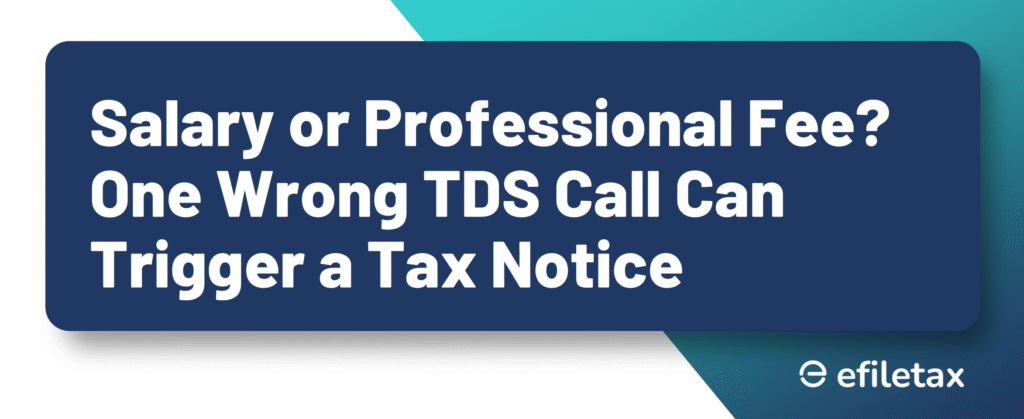
Section 192 vs. 194J – Key Difference in TDS Explained
Section 192 vs. 194J is a crucial distinction every employer, consultant, and tax advisor must understand. Both deal with Tax Deducted at Source (TDS) but apply in completely different contexts – one for salaries and the other for professional services. Misclassifying payments can lead to heavy penalties and scrutiny.
What is Section 192?
Section 192 applies when an employer pays salary to an employee. Here’s what makes it distinct:
- TDS deducted on actual salary paid
- Based on applicable income tax slab rates
- Deductor: Employer
- Declaration: Employee must provide PAN and investment proofs
- No fixed TDS rate – calculated annually or monthly
Example:
A CA employed full-time with a company on payroll will attract TDS under Section 192.
What is Section 194J?
Section 194J applies when a payment is made to a professional or technical consultant (not an employee). Features include:
- Flat 10% TDS (reduced to 7.5% temporarily in FY 2020–21 due to COVID relief)
- Applies to doctors, CAs, lawyers, engineers, designers, freelancers etc.
- Deductor: Any person (individual/HUF if audit applicable)
- No slab rate – flat deduction on gross bill amount
Example:
A freelance CA who audits your books and raises an invoice is covered under Section 194J.
Key Differences: Section 192 vs. 194J
| Particulars | Section 192 – Salary | Section 194J – Professional Fees |
|---|---|---|
| Relationship | Employer-Employee | Principal–Independent Professional |
| Nature of Payment | Salary | Professional / Technical Fees |
| TDS Rate | As per income slab | Flat 10% (or lower as notified) |
| PAN Requirement | Mandatory | Mandatory |
| Tax Calculation Basis | Based on estimated annual income | Fixed % on each invoice |
| Declaration by Payee | Investment proofs, Form 12BB | No need to declare exemptions |
| Form Issued | Form 16 | Form 16A |
CBDT View and Legal Tests
- CBDT Circular No. 715 (1995): If the payment is in the nature of salary, even if named ‘consultancy fee’, TDS must be under Section 192.
- Supreme Court in Ram Krishna Vedantam v. UOI (2020): Nature of relationship (control, working hours, reporting structure) is key in deciding employer-employee link.
- KPMG vs. CIT (2011): Merely issuing Form 16A doesn’t determine correctness – factual nature of work matters.
When Confusion Arises: Common Scenarios
- Retired Government Officers hired as advisors: If full-time with supervision – Section 192. If independent project-based – Section 194J.
- Doctors in hospitals: If fixed duty, control, salary – Section 192. If visit-based with no supervision – Section 194J.
Expert Tip: Avoiding Litigation
👉 Run a ‘Control Test’ before deciding the TDS section:
- Do you supervise the person’s daily work?
- Is the work integral to your operations?
- Is the person eligible for paid leave, PF, or gratuity?
If yes, it’s likely Section 192.
Compliance Checklist for Businesses
- Always issue appropriate TDS certificates: Form 16 for Section 192, Form 16A for Section 194J
- Verify contract terms – do not rely on titles alone
- Maintain declarations or agreements to justify the nature of the relationship
- If in doubt, seek clarification under Section 197 (Lower/Nil TDS)
Summary
Section 192 vs. 194J explains how TDS differs on salaries and professional fees. Employers must assess the nature of work, level of control, and relationship structure to apply the correct section. Misclassification can trigger TDS defaults, penalties, and tax scrutiny.
FAQs
Q1. Can a consultant be taxed under Section 192?
Yes, if the person works like an employee – with fixed hours, supervision, and salary-like benefits.
Q2. What happens if TDS is wrongly deducted under Section 194J instead of 192?
The tax department may disallow the expense or raise a TDS shortfall demand.
Q3. Are part-time consultants always under 194J?
Usually yes, unless their role mimics that of an employee in all practical aspects.
Final Note
Before making TDS deductions, draw a clear line between an employee and a consultant. Efiletax helps you classify, deduct, and file TDS compliantly.